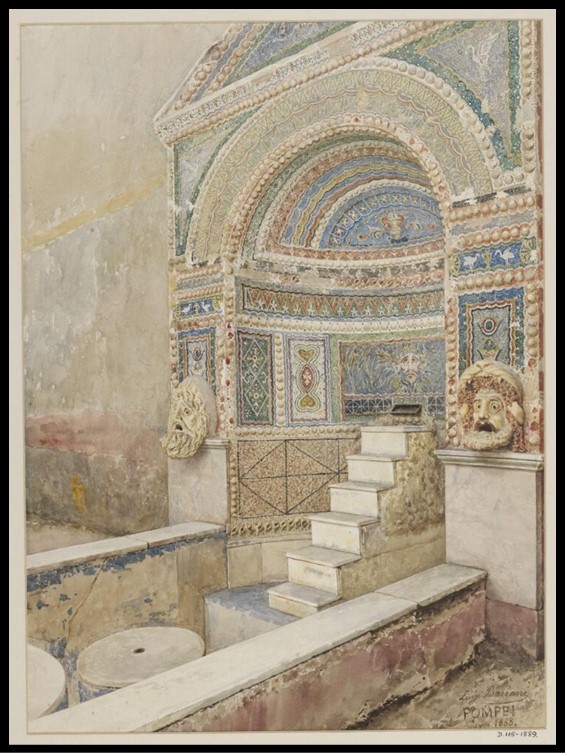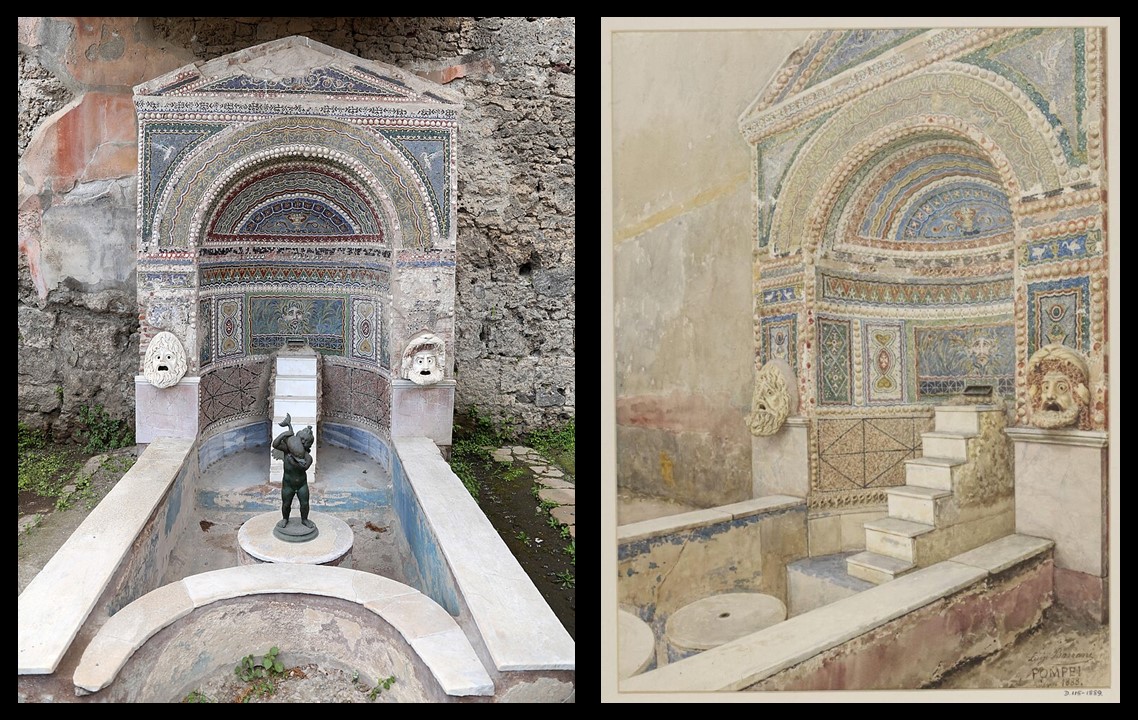
A fountain in Pompeii (House of the Large Fountain, Pompeii), 1888, Watercolour on Paper, 46.35x 35.56 cm, Victoria and Albert Museum, London, UK https://collections.vam.ac.uk/item/O406355/painting-of-pompeii-drawing-luigi-bazzani/#object-details
I’m not sure if you enjoy Japanese Haiku, those three-line, 17-syllable poems, but as I gaze at Luigi Bazzani’s Watercolours of Pompeii in the Victoria and Albert Museum, I’m reminded of the Haiku games I once shared with my students. And with that, a new Haiku unfolds… Ancient stones speak soft, / Bazzani’s brush finds their voice, / Pompeii breathes anew.
Luigi Bazzani (1836–1927) was an Italian painter and architect born in Bologna. A master of both watercolors and detailed architectural renderings, Bazzani initially trained in the fine arts at the Accademia di Belle Arti in Bologna. His early works were primarily focused on landscapes and genre scenes, but he soon became captivated by ancient Roman architecture and archaeological subjects, which shaped his career. By the mid-19th century, he had joined a circle of artists, archaeologists, and scholars based in Rome, where he further refined his skills in portraying architectural details with exceptional precision. This passion led Bazzani to work extensively in archaeological illustration, making him a key figure in documenting Italy’s historical sites.
Bazzani’s work took on new significance when he became actively involved in the excavation and study of Pompeii. At the time, the archaeological site was undergoing one of its most intensive periods of excavation, and Bazzani’s watercolors played a vital role in visually recording the ruins before further deterioration. His paintings, known for their remarkable detail, accuracy, and fidelity to the textures of ancient stonework, served both scientific and artistic purposes. His ability to evoke the atmosphere of ancient Pompeii made him a celebrated artist among scholars and art lovers alike, particularly as his work bridged the realms of historical documentation and creative expression. Through his paintings, Bazzani preserved not just the structures of Pompeii but also conveyed a sense of the city’s former life and vibrancy.

A fountain in Pompeii (House of the Large Fountain, Pompeii), 1888, Watercolour on Paper, 46.35x 35.56 cm, Victoria and Albert Museum, London, UK https://collections.vam.ac.uk/item/O406355/painting-of-pompeii-drawing-luigi-bazzani/#object-details
House of the Large Fountain, 2nd century BC to 1st century AD, Pompeii (Regio VI Insula 8.22), Italy
https://www.planetpompeii.com/en/map/the-house-of-large-fountain/524-the-house-of-large-fountain.html
His artistic approach combined meticulous attention to detail with a romantic sensibility that brought depth and emotion to his portrayals of Pompeii. His use of watercolor allowed him to capture the luminous quality of Mediterranean light, which he skillfully balanced with shadow and contrast to convey the depth and scale of ancient architecture. Bazzani’s works are characterized by an almost photographic realism, yet they go beyond mere documentation, subtly imbuing his subjects with a sense of nostalgia for a lost world. His brushwork reveals an intimate knowledge of architectural form and materials, while his ability to evoke atmospheric conditions gives his scenes a timeless, almost haunting beauty. Through Bazzani’s artistry, the viewer not only sees Pompeii’s ruins but also senses the city’s enduring spirit.
The Victoria and Albert Museum houses a notable collection of Luigi Bazzani’s watercolors depicting the ancient site of Pompeii, showcasing his unparalleled skill in capturing the ruins with both accuracy and artistic flair. These works offer a vivid glimpse into the archaeological site during the late 19th and early 20th centuries, a period of intense excavation and exploration. Bazzani’s watercolors at the V&A highlight his meticulous attention to architectural detail and his ability to evoke the atmosphere of the ancient city, from crumbling walls to the intricate textures of stone and frescoes. Through these works, the museum preserves not only a historical record of Pompeii’s ruins but also an artistic interpretation of the past, allowing viewers to experience the city as it once stood—alive with the vibrancy of Roman life, even as it faced the inexorable passage of time.
The Louigi Bazzani watercolour painting of a Pompeiian Fountain within a highly decorated alcove, is a wonderful reconstruction of the Mosaic Fountain discovered in the Pompeiian House of the Large Fountain. The Pompeiian Houseis discussed… https://www.teachercurator.com/ancient-roman-villas/house-of-the-large-fountain/
For a PowerPoint on Luigi Bazzani’s Pompeian oeuvre, please… Click HERE!
Bibliography: https://collections.vam.ac.uk/search/?id_person=AUTH347957&page=1&page_size=15